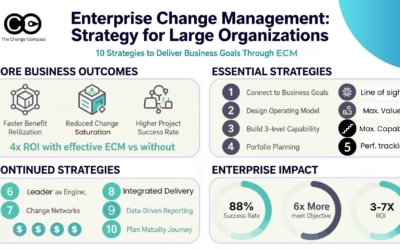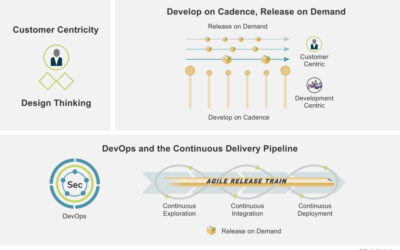A change impact is the direct result of an initiative that alters how people understand, perform, and experience their work, requiring time and adaptation to embrace new ways of operating. Looking deeper, it’s important to dive deep into many examples of impacts, examine the distinction between change impact assessments and perceived impacts, explore how impacts are managed at project, business unit, and enterprise levels.
Understanding Change Impact
A change impact occurs when an organisational initiative transforms the experience, behaviours, or responsibilities of employees or customers. These changes may involve new systems, processes, roles, policies, or even shifts in customer interaction, each demanding varying levels of adjustment.
For example:
- Introducing a new system may require subject matter experts to contribute to system design, end-users to attend information sessions, train superusers, and receive briefings and hands-on training, eventually embedding the system into daily operations.
- Rolling out a new customer-facing process might impact frontline employees’ scripts, reporting protocols, and the customer journey, requiring revised training, updated communication, and monitored feedback.
Impacts in Change Impact Assessment
Change impact assessments (CIA) are formal exercises conducted by change managers to systematically evaluate and document the nature, breadth, and severity of anticipated impacts on stakeholder groups. This process typically compares the “current state” versus the “future state” and identifies who will be affected, what will change, when those changes will occur, and how severe the impacts may be.
Typical categories of change impacts include:
- People: Role changes, skills required, team structures, new responsibilities.
- Processes: Workflow alterations, procedural changes, compliance requirements.
- Technology: New platforms, system integrations, changed user interfaces.
- Customers: Adjusted service processes, different touchpoints, shifted expectations.
Change impact assessments drive the development of change management strategies, help mitigate risks, and ensure tailored activities and communications for impacted groups.
Perceived Impacts from the End User’s Perspective
While change managers articulate impacts as identified in impact assessments, end users and target audiences often perceive impacts through the lens of tangible activities and interventions:
- End User Perception: End users may see impacts as more immediate activities such as training sessions, workshops, communications, meetings, or changes in their day-to-day workflow. For them, “impacts” are what alters their routine, requires their participation, or changes their expectations and deliverables.
This distinction is critical: impact assessments document what is objectively changing, whereas perceived impacts are what end users subjectively experience.
Concrete Examples of Change Impact
Here are additional examples illustrating varied change impacts:
- A new HR platform that automates leave requests changes both back-office processes and how employees manage personal time off, requiring training, updated policies, and FAQ sheets.
- A business division restructuring creates new reporting lines, necessitating job description updates, role mapping sessions, and team realignment meetings.
- Transitioning to a remote-first work environment demands workflow system changes, digital communication protocols, and employee engagement activities.
More inspiration, examples, and scenarios can be found throughout the Knowledge Centre, such as in the articles:
- Human centred impact assessment workshop design
- Human centric view of change impacts
- OCM deliverables: Your comprehensive structural guide
Managing Change Impacts: Levels and Approaches
Project Level
At the project level, change impacts are most acute and easily mapped, and are directly tied to specific deliverables and stakeholder groups. Change managers identify and prioritize impacts, tailoring interventions such as communications, training, support resources, and feedback mechanisms.
- Example: Implementing a new inventory management system; project-level impacts include changes to stock tracking processes for warehouse staff, updated reporting workflows for supervisors, and new ordering procedures for procurement.
Business Unit / Division Level
Business units or divisions experience cumulative and overlapping impacts from multiple concurrent projects. Management must consider resource capacity, operational continuity, and the risk of “change saturation”, where too many initiatives and impacts overwhelm teams.
- Effective impact management demands aggregation of project-level assessments, coordination of timings, and prioritization of initiatives.
- Example: A retail division launching two new sales systems and a revised product policy within six months may require a coordinated rollout to balance staff workload, avoid confusion, and maintain morale.
Enterprise Level
At the enterprise level, holistic visibility over all change impacts allows for “air traffic control”, balancing and sequencing changes for optimal organisational health. Leaders use enterprise change portfolios to oversee major projects, recognize interdependencies, and prevent conflicting or excessive impacts.
- Enterprise Change Control: Techniques include impact heatmaps, capacity planning, project portfolio reviews, and centralised communications.
- Example: An enterprise-wide transformation program spanning digital, regulatory, and customer excellence initiatives needs a structured framework to align impacts, support business units, and report on progress.
More advice and methods for managing impacts at scale are found in:
- The Knowledge Centre—covering best practices, impact prioritization strategies, and enterprise change management guidelines.
- Re-thinking the Change Impact Assessment for diagnosing effects and reducing negative implications.
Impact Evaluation vs. Change Impact Assessment
It’s important to distinguish project impact evaluation (used in program evaluation to measure observed outcomes and causal attribution) versus change impact assessment (used in change management to anticipate and plan for people impacts).
Building Resilient Change Across Levels
Managing impacts effectively requires collaboration, continuous feedback, and alignment of project-level activities with business unit and enterprise priorities. Key tools include:
- Change calendars and heatmaps
- Stakeholder engagement plans
- Impact tracking dashboards
- Change saturation analysis
Change impacts shape not just project success but the overall experience of employees, customers, and stakeholders. By distinguishing between change impact assessments and user-perceived impacts, and managing at project, business unit, and enterprise levels, organisations create a coordinated framework for change by optimizing resources, reducing risk, and enhancing adaptability.






